|
|
|
Sort Order |
|
|
|
Items / Page
|
|
|
|
|
|
|
| Srl | Item |
| 1 |
ID:
062341


|
|
|
| 2 |
ID:
081383
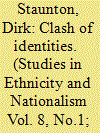

|
|
|
|
|
| Publication |
2008.
|
| Summary/Abstract |
Globalisation is affecting communities of people in sometimes surprising ways. One such impact of globalisation has been on the Islamic identity of salafi jihadi groups. Globalisation is driving a decontextualised and deculturalised conception of Islam within salafi jihadi organisations and this fuels identity conflicts with other Muslim groups based on competition between cultural and 'anticultural' forces. This identity conflict culminates in terrorism as a rational and political attempt to 'securitise' group identities that are under attack. This paper seeks to shed light on what is animating salafi jihadi terrorism and examines the Indonesian organisation Jemaah Islamiyah as a case study. The paper concludes that globalisation is leaving a 'footprint' on societies, influencing political and religious movements and inflaming identity conflicts, and that this leads to terrorism. It is thus important that theorists develop detailed proposals to offset the negative impacts of globalisation on global security
|
|
|
|
|
|
|
|
|
|
|
|
|
|
|
|
| 3 |
ID:
152872
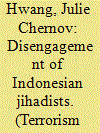

|
|
|
|
|
| Summary/Abstract |
While much research has been conducted on the radicalization of Muslim militants from Jemaah Islamiyah, its spinoffs, and splinter factions; the historical roots of Indonesian radical movements; and their ideological underpinnings, far less analysis has centered on how and why individual militants may come to disengage from violence. Disengagement is defined as a gradual process through which a member of a terror group, radical movement, gang, or cult comes to reject the use of terror methods in pursuit of their goals. Utilizing original fieldwork conducted between 2010 and 2014, with fifty current and former members of Islamist extremist groups in Indonesia, this article will unpack the patterns, pathways, religious considerations, and psychological processes that propel individual militants to turn away from violence.
|
|
|
|
|
|
|
|
|
|
|
|
|
|
|
|
| 4 |
ID:
123219
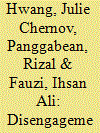

|
|
|
|
|
| Publication |
2013.
|
| Summary/Abstract |
To what extent are jihadists in Indonesia disengaging from violence? Based on original fieldwork in Jakarta and Central Sulawesi, including interviews with 23 current and former Poso-based jihadists, we examine the emotional, psychological, rational, and relational factors that can lead militants to turn away from terror tactics.
|
|
|
|
|
|
|
|
|
|
|
|
|
|
|
|
| 5 |
ID:
057163
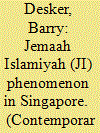

|
|
|
| 6 |
ID:
099824


|
|
|
|
|
| Publication |
2010.
|
| Summary/Abstract |
Jemaah Islamiyah (JI) has shifted its structure and strategies several times since its inception, and its ability to evolve over time has ensured its survival. This article evaluates the evolution of JI's influence in Indonesia and its shift in strategy, in an attempt to address the broader issue of its survival as an organization. It hypothesizes that while internal factors initiated the current strategy shift to an ideological and political focus, external factors have successfully exploited and solidified that shift. Explaining JI's historical evolution in four phases, it concludes by considering possibilities for a "fifth phase" of peaceful political participation.
|
|
|
|
|
|
|
|
|
|
|
|
|
|
|
|
| 7 |
ID:
093702
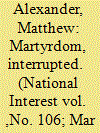

|
|
|
|
|
| Publication |
2010.
|
| Summary/Abstract |
THE SEVEN-year manhunt came down to this. In the wee morning hours of a September dawn, Noordin Mohammed Top, the most wanted terrorist in Southeast Asia, huddled in a burning house in central Java along with three of his men. The fire started when a round shot by police in the initial standoff ignited the fuel tank of a motorcycle inside the courtyard of the house, forcing Top to seek refuge in the bathroom, where he decided to make his final stand. Top believed that dying during what he considered to be legitimate jihad would earn him a seat in heaven, and taking a few apostate policemen with him would ensure a bonus reward in the afterlife. The Indonesian police had come close to catching Top before, but he proved to be an elusive, and lethal, fugitive. Perhaps this would be their moment of glory.
|
|
|
|
|
|
|
|
|
|
|
|
|
|
|
|
| 8 |
ID:
167182
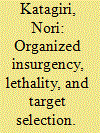

|
|
|
|
|
| Summary/Abstract |
I examine the relationship between organizational stability, lethality, and target selection, and attack method of Southeast Asian insurgency. I do so by comparing the Abu Sayyaf Group (ASG) and Jemaah Islamiyah (JI), using data of their activities between 1994 and 2015. I make two arguments. First, organizationally unstable insurgency groups tend to see their members increase generate more casualties, while stable groups often experience reduction of violence. Second, organizational instability makes it more likely for groups to target civilian populations and business infrastructure than government, military and police forces, and transportation buildings. In contrast, organizational stability has limited explanatory power on its attack methods.
|
|
|
|
|
|
|
|
|
|
|
|
|
|
|
|
| 9 |
ID:
149542
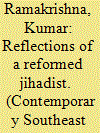

|
|
|
|
|
| Summary/Abstract |
On 29 August 2012, a rehabilitated former senior member of the Jemaah Islamiyah (JI) terror network, Wan Min Wan Mat, delivered a lecture to a group of Malaysian counter-terrorism practitioners in which he sketched out the ideological rationale and aims of the JI network, unpacked in some detail its recruitment and indoctrination philosophy and methodology and also examined what in his personal view are potentially useful strategies for rehabilitating JI militants or preventing the further dissemination of JI extremist ideas. This article examines and evaluates some of the key insights made by Wan Min in his lecture, and argues that his musings are more than mere historical interest in that they have direct relevance to the current struggle against the latest incarnation of the continually evolving violent jihadist threat in Southeast Asia and globally, namely the Islamic State of Iraq and Syria (ISIS or IS). The central reason for this is that the same broad ideology that animated JI — Salafi Jihadism — basically motivates ISIS as well. Hence, even allowing for dissimilarities in time and space, Wan Min’s insights about JI could well provide useful pointers for counter-terrorism practitioners and specialists dealing with the ISIS threat today.
|
|
|
|
|
|
|
|
|
|
|
|
|
|
|
|
| 10 |
ID:
073768
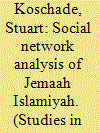

|
|
|
|
|
| Publication |
2006.
|
| Summary/Abstract |
This article attempts to contribute to and advance the growing literature on social network analysis and terrorism studies, through a social network analysis of the Jemaah Islamiyah cell that was responsible for the Bali bombings in 2002. In doing so, the article endeavors to provide a potential framework for the intelligence analysis of terrorist cells. Such a framework will assist in (1) understanding the communication and structure of such cells and (2) assist in predicting the likely outcomes of terrorist cells when employed in real-time intelligence analysis.
|
|
|
|
|
|
|
|
|
|
|
|
|
|
|
|
| 11 |
ID:
163208
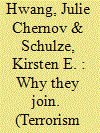

|
|
|
|
|
| Summary/Abstract |
Why do Indonesian Muslims join Islamist extremist groups? This article explores four pathways to entry into Indonesian militant groups: study sessions, local conflict, kinship, and schools. It argues that within all four of these pathways, social bonds and relationships are the common thread in encouraging entry as well as in fostering commitment. Specifically, these relationships contribute to the formation and eventual consolidation of one’s identity as a member of the jihadi group through regular participation in activities, attending meetings, narrowing the circle of friends to those within the group, and participating in increasingly risky and possibly violent activities together. Drawing on original fieldwork including 49 interviews with current and former members of Jemaah Islamiyah, Mujahidin KOMPAK, Darul Islam, Mujahidin Tanah Runtuh, Indonesia’s pro-ISIS network, and other jihadist groups as well as 57 depositions and court documents, this article explores the development and evolution of these pathways and how relational ties play a role in each
|
|
|
|
|
|
|
|
|
|
|
|
|
|
|
|
|
|
|
|
|